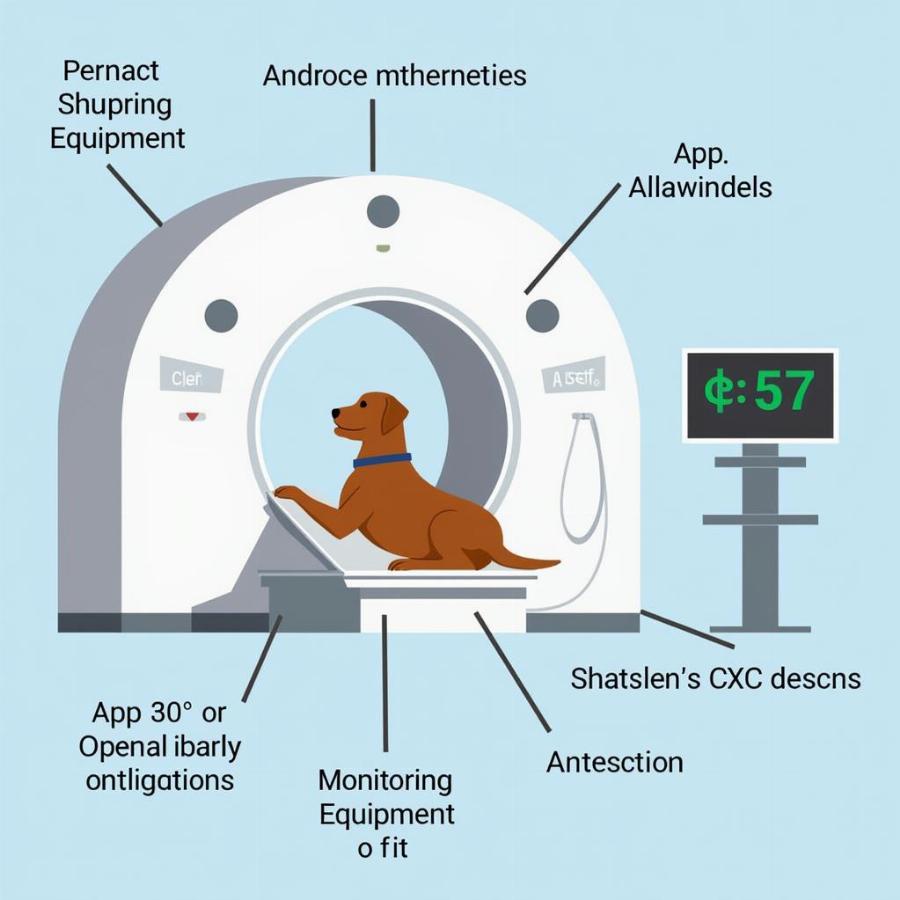Understanding the costs associated with advanced diagnostic imaging like an MRI for your furry friend is crucial. While an MRI can provide invaluable insights into your dog’s health, it’s an investment. This article will break down the factors influencing the cost of a dog MRI, offer tips for managing expenses, and explore alternative diagnostic options.
Factors Affecting Dog MRI Costs
Several factors contribute to the final price tag of a canine MRI. Understanding these can help you prepare and make informed decisions.
- Geographic Location: Just like human healthcare, veterinary costs vary by location. Metropolitan areas or regions with specialized veterinary hospitals tend to have higher prices.
- Veterinary Clinic: Some clinics invest in their own MRI equipment, while others refer patients to specialty imaging centers. Referral centers might have higher fees due to specialized staff and equipment.
- Complexity of the Procedure: The specific area being scanned (brain, spine, limbs) and the need for contrast agents can impact the overall cost. More complex procedures requiring longer scan times and specialized interpretation will likely be more expensive.
- Anesthesia and Monitoring: Anesthesia is necessary for MRIs to ensure your dog remains still during the scan. The type of anesthesia, monitoring equipment used, and the duration of the procedure all contribute to the cost.
- Additional Services: Pre-anesthetic bloodwork, intravenous fluids, and post-procedure medications are often necessary and add to the overall expense.
 Dog MRI Procedure and Associated Costs
Dog MRI Procedure and Associated Costs
What to Expect: Typical Dog MRI Price Range
While the exact cost varies, a dog MRI can range from $1,500 to $5,000, and sometimes even higher. This price typically includes the scan itself, anesthesia, and monitoring. It’s crucial to discuss all potential costs with your veterinarian beforehand to avoid any surprises.
Is Pet Insurance an Option?
Many pet insurance policies cover diagnostic imaging, including MRIs. If you have pet insurance, check your policy details to understand the extent of coverage and any applicable deductibles or co-pays. Having pet insurance can significantly reduce the financial burden of an MRI.
Exploring Alternatives to MRI for Dogs
Depending on the suspected condition, alternative diagnostic tools might be suitable. While these might not provide the same level of detail as an MRI, they can be less expensive and still offer valuable information. These alternatives include X-rays, ultrasounds, and CT scans. Discuss these options with your vet to determine the best approach for your dog’s specific situation. For example, if you suspect a common petuitary disorder, an coomon petuitary disorders in dogs might offer further insights.
When is an MRI the Best Option?
Despite the cost, an MRI is often the preferred diagnostic tool for certain conditions. It provides unparalleled detail for soft tissues, making it invaluable for diagnosing neurological issues, spinal cord injuries, and certain types of tumors. Your veterinarian will recommend an MRI when its diagnostic capabilities outweigh the cost considerations. Sometimes, advanced imaging is necessary to accurately diagnose issues like hip dysplasia dog radiogrpahs reveal.
Managing the Financial Burden of a Dog MRI
- Financial Planning: Start saving for potential veterinary expenses as soon as you bring your dog home. Even a small monthly contribution can make a big difference.
- Payment Plans: Discuss payment plan options with your veterinarian or the imaging center. Many offer flexible payment options to make the procedure more affordable.
- Charitable Organizations: Some organizations offer financial assistance for pet medical care. Research local and national organizations that might be able to help.
Conclusion
While the cost of an MRI for a dog can be significant, it’s an important diagnostic tool that can provide invaluable information for your pet’s health. By understanding the factors affecting the cost and exploring alternative options, you can make informed decisions. Remember, early diagnosis and treatment often lead to better outcomes. Similarly, understanding the potential cost of diagnosing conditions like an ectopic ureter dog can be beneficial.
FAQ
- Does pet insurance always cover MRIs? No, coverage varies depending on the specific policy.
- Are there financing options for dog MRIs? Yes, many veterinary clinics offer payment plans.
- Can an X-ray be used instead of an MRI? X-rays are useful for bone issues, but MRIs provide more detail for soft tissues.
- How long does a dog MRI take? Typically, 30 to 60 minutes, including anesthesia time.
- Is an MRI painful for dogs? No, dogs are under general anesthesia during the procedure.
- What are the risks of anesthesia for dogs? While generally safe, anesthesia always carries some risks.
- How do I find a veterinary clinic that offers MRIs? Your primary veterinarian can provide referrals to specialty imaging centers. Issues like an acl tear in a dog also require accurate diagnosis.
If you are considering a diagnostic imaging approach for your dog, understanding the specifics of imaging modalities like a dog in him xray can help inform your decision.
Beaut Dogs is your trusted resource for comprehensive information about dog breeds, care, and health. We’re passionate about providing valuable insights to help you provide the best care for your canine companion. For personalized advice and support, please contact us via Email: [email protected]. Beaut Dogs is dedicated to helping you navigate the world of canine care with confidence. Visit us at https://beautdogs.com to learn more.